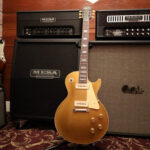As a long-time guitar player with a history deeply rooted in the Les Paul lineage, I feel uniquely positioned to offer an insightful perspective on the Les Paul Standard Guitar. My journey began with a Japanese Les Paul Custom copy from Ibanez, and later progressed to owning a genuine ’87 Les Paul Standard. While I eventually sold that Standard to fund a PRS, the Les Paul’s impact on my playing and understanding of guitar design remains significant. Having explored Les Pauls across various production years and iterations, including the SG, Junior, and Studio models, I can confidently delve into the enduring appeal and potential drawbacks of this iconic instrument.
The Les Paul Standard guitar is undeniably an archetype in the guitar world. Its core attributes are instantly recognizable: three fundamental sonic flavors achievable through pickup switching, seemingly endless sustain, classic aesthetics, and a design that, remarkably, has remained largely consistent for over half a century. This enduring formula is a testament to its inherent quality and appeal. If the quintessential, heavy, sustain-rich sound is what you seek, owning a Les Paul Standard at least once is almost a rite of passage for any serious guitarist.
What resonated most with me during my time with a Les Paul Standard were its standout qualities. The sustain was truly remarkable, allowing notes to ring out and feedback in a way few other guitars could match. The shorter scale length contributed to a slinkier feel under the fingers, making bending and vibrato feel effortless. And of course, the heavy, thick tone was perfect for rock and blues riffs, delivering a powerful and commanding sonic presence.
However, the Les Paul Standard is not without its limitations. The tonal palette, while classic, can feel somewhat restricted compared to more versatile instruments. The neck profile, often described as thick, wasn’t always the most comfortable for extended playing sessions, particularly for players with smaller hands. Lastly, the sheer weight of the Les Paul Standard can become a factor, especially during long gigs or rehearsals, leading to fatigue.
My personal quest for tonal versatility ultimately led me to part ways with my Les Paul Standard in favor of a PRS. This was well before PRS guitars became associated with any particular genre or trend; I was simply drawn to the broader range of sounds it offered. While the PRS was indeed more tonally flexible, it still didn’t quite capture the pristine clean tones I desired. As a result, it now resides primarily in its case, perhaps destined to become a collector’s item.
Seeking a guitar that could bridge the gap between heavy rock tones and articulate cleans, I discovered the Music Man Axis Sport with MM90 pickups. This guitar proved to be a revelation. It effortlessly covers both high-gain and clean sonic territories, boasts a significantly lighter weight than a Les Paul Standard, and features what is, for me, the most consistently comfortable neck of any guitar I’ve ever played. Tonally, it leans closer to a Les Paul Junior – a model I’ve always appreciated for its raw and primal character – but with a touch more refinement. The Axis Sport, in essence, offers a “refined raw” sound that perfectly suits my preferences.
In terms of build quality, my ’87 Les Paul Standard was adequate, although I acquired it used and it had a neck warp that required correction. Les Pauls are also known to be vulnerable to headstock breaks due to the angled design, a repair that, while common, isn’t inexpensive – thankfully, I never experienced this issue. While some Gibson purists might criticize the quality of 80s Gibsons and assert improvements in recent years, the price point of new Les Paul Standards often seems disproportionate to what you receive. It’s frankly surprising to see more visually striking figured maple tops on budget-friendly Epiphone Les Pauls than on many Gibson Custom Shop offerings. The premium price largely reflects the legendary Gibson name, although it’s fair to acknowledge that Gibson instruments likely involve more hands-on craftsmanship compared to many bolt-on guitars. However, in my experience, the overall playability, engineering, and wood selection across the Ernie Ball Music Man (EBMM) line surpass those of Gibson.
Is my Axis Sport a Les Paul? No, it’s its own thing. Would an EVH or standard Axis be considered closer to a Les Paul Standard guitar? Arguably, yes, as it’s a humbucker-equipped, heavy rock-oriented instrument. However, any Axis model offers significantly greater tonal versatility than a Les Paul Standard, not to mention being kinder to your wallet and your back! Ultimately, comparing an Axis to a Les Paul Standard is akin to comparing apples to oranges. One is a brighter-sounding, bolt-on, longer-scale instrument constructed with lighter woods and often featuring a tremolo system. The other is a short-scale, fixed-neck guitar with a heavier overall sonic character.
In a final reflection, I recently had the opportunity to purchase a used US-made Les Paul Studio for a very attractive price of $450. Despite the tempting deal, I ultimately declined, opting to allocate those funds towards a future EBMM acquisition. This decision underscores my current preference, but it doesn’t diminish the legacy and enduring appeal of the Les Paul Standard guitar. It remains a cornerstone of electric guitar history and a benchmark against which many other instruments are still measured.

